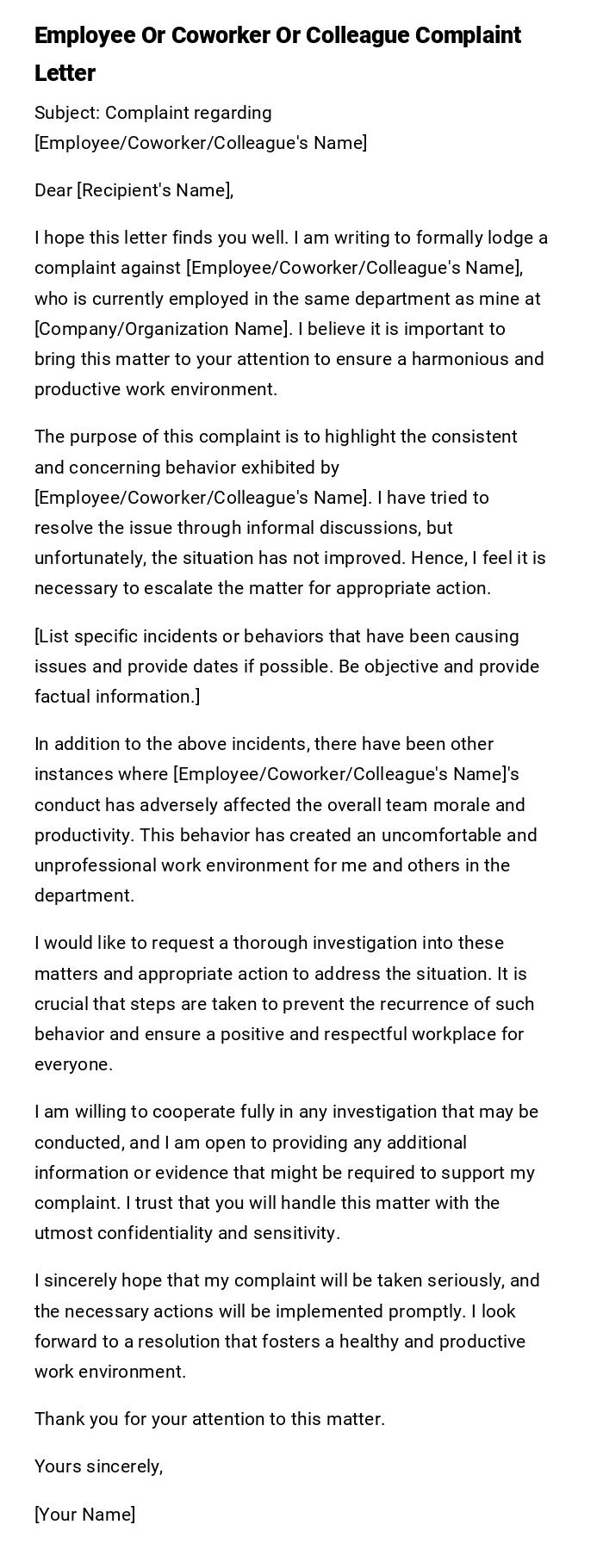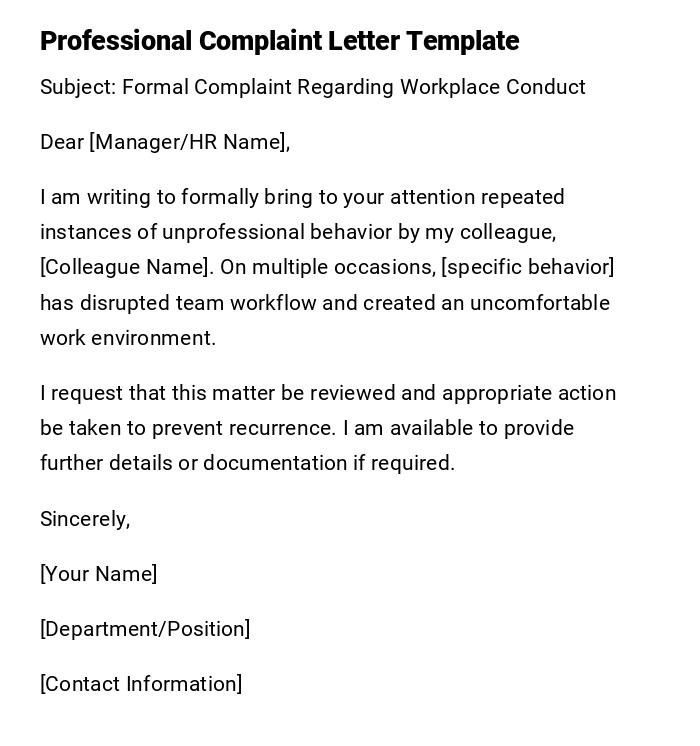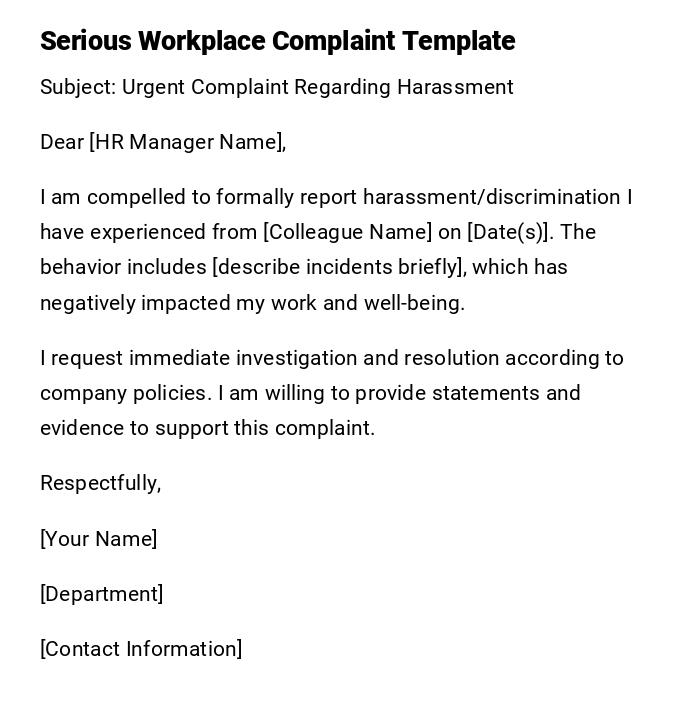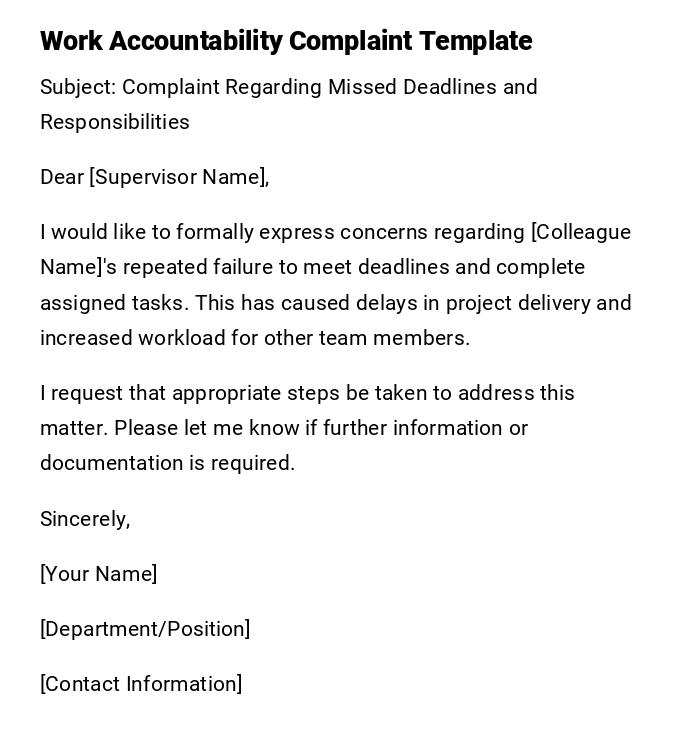Employee Or Coworker Or Colleague Complaint Letter
Subject: Complaint regarding [Employee/Coworker/Colleague's Name]
Dear [Recipient's Name],
I hope this letter finds you well. I am writing to formally lodge a complaint against [Employee/Coworker/Colleague's Name], who is currently employed in the same department as mine at [Company/Organization Name]. I believe it is important to bring this matter to your attention to ensure a harmonious and productive work environment.
The purpose of this complaint is to highlight the consistent and concerning behavior exhibited by [Employee/Coworker/Colleague's Name]. I have tried to resolve the issue through informal discussions, but unfortunately, the situation has not improved. Hence, I feel it is necessary to escalate the matter for appropriate action.
[List specific incidents or behaviors that have been causing issues and provide dates if possible. Be objective and provide factual information.]
In addition to the above incidents, there have been other instances where [Employee/Coworker/Colleague's Name]'s conduct has adversely affected the overall team morale and productivity. This behavior has created an uncomfortable and unprofessional work environment for me and others in the department.
I would like to request a thorough investigation into these matters and appropriate action to address the situation. It is crucial that steps are taken to prevent the recurrence of such behavior and ensure a positive and respectful workplace for everyone.
I am willing to cooperate fully in any investigation that may be conducted, and I am open to providing any additional information or evidence that might be required to support my complaint. I trust that you will handle this matter with the utmost confidentiality and sensitivity.
I sincerely hope that my complaint will be taken seriously, and the necessary actions will be implemented promptly. I look forward to a resolution that fosters a healthy and productive work environment.
Thank you for your attention to this matter.
Yours sincerely,
[Your Name]
Complaint About Unprofessional Behavior by a Colleague
Subject: Formal Complaint Regarding Workplace Conduct
Dear [Manager/HR Name],
I am writing to formally bring to your attention repeated instances of unprofessional behavior by my colleague, [Colleague Name]. On multiple occasions, [specific behavior] has disrupted team workflow and created an uncomfortable work environment.
I request that this matter be reviewed and appropriate action be taken to prevent recurrence. I am available to provide further details or documentation if required.
Sincerely,
[Your Name]
[Department/Position]
[Contact Information]
Complaint About Harassment or Discrimination at Work
Subject: Urgent Complaint Regarding Harassment
Dear [HR Manager Name],
I am compelled to formally report harassment/discrimination I have experienced from [Colleague Name] on [Date(s)]. The behavior includes [describe incidents briefly], which has negatively impacted my work and well-being.
I request immediate investigation and resolution according to company policies. I am willing to provide statements and evidence to support this complaint.
Respectfully,
[Your Name]
[Department]
[Contact Information]
Complaint About Unmet Work Commitments
Subject: Complaint Regarding Missed Deadlines and Responsibilities
Dear [Supervisor Name],
I would like to formally express concerns regarding [Colleague Name]'s repeated failure to meet deadlines and complete assigned tasks. This has caused delays in project delivery and increased workload for other team members.
I request that appropriate steps be taken to address this matter. Please let me know if further information or documentation is required.
Sincerely,
[Your Name]
[Department/Position]
[Contact Information]
Complaint About Workplace Safety Negligence
Subject: Complaint Regarding Safety Negligence
Dear [Manager/HR Name],
I am writing to report repeated unsafe practices observed by [Colleague Name] in the workplace. These actions, including [describe behavior], put both staff and company property at risk.
I request immediate review and corrective measures to ensure workplace safety. Documentation and evidence are available if needed.
Thank you for your attention to this matter.
Sincerely,
[Your Name]
[Department/Position]
[Contact Information]
Complaint About Team Disruption or Miscommunication
Subject: Formal Complaint Regarding Team Communication Issues
Dear [Manager Name],
I would like to formally report ongoing issues with [Colleague Name]'s communication and collaboration. Miscommunication, delays in responding, and uncoordinated actions have disrupted team workflow.
I request a review of these concerns and guidance on corrective measures. I am available to discuss details further if necessary.
Best regards,
[Your Name]
[Position/Department]
[Contact Information]
What / Why: Purpose of an Employee Complaint Letter
- Provides a formal channel to report workplace issues with colleagues or coworkers.
- Ensures management or HR is aware of disruptive behavior, harassment, or neglect of responsibilities.
- Creates documentation that can be used for resolving disputes and implementing corrective actions.
Who Should Send an Employee Complaint Letter
- Employees directly affected by another colleague's actions.
- Team members observing repeated unprofessional conduct.
- Individuals seeking resolution of harassment, discrimination, safety violations, or workflow disruptions.
Whom the Complaint Letter Should Be Addressed To
- Direct manager or supervisor overseeing the team.
- Human Resources department for formal investigation.
- Senior management if initial reporting channels are ineffective.
- Relevant authorities within the organization responsible for compliance or workplace safety.
When to Send an Employee Complaint Letter
- After witnessing repeated unprofessional behavior or harassment.
- Following failed attempts to resolve the issue informally.
- When workplace safety or company policy is compromised.
- Prompt reporting ensures timely investigation and corrective action.
How to Write and Send an Employee Complaint Letter
- Begin with a clear subject line describing the nature of the complaint.
- Include specific dates, incidents, and individuals involved.
- Maintain a professional and factual tone; avoid emotional language.
- Request action or investigation by the recipient.
- Sign and include contact information for follow-up.
- Deliver via email, internal HR portal, or printed letter with acknowledgment.
Requirements and Prerequisites Before Writing
- Document incidents with dates, times, and witnesses if possible.
- Review company policies regarding complaints, harassment, and dispute resolution.
- Ensure clarity on the expected outcome or action desired.
- Gather any supporting evidence such as emails, messages, or reports.
Formatting Guidelines for Employee Complaint Letters
- Length: concise, typically one page but detailed enough for context.
- Tone: formal, factual, and professional.
- Wording: avoid accusations; focus on observed behaviors and impact.
- Structure: subject line, introduction, description of incidents, request for action, closing with signature.
- Mode: internal email or printed submission per company procedure.
After Sending / Follow-up Procedures
- Confirm receipt with HR or manager if necessary.
- Keep copies of all communications for personal records.
- Be prepared to provide additional details or attend meetings.
- Track progress of investigation and resolution.
Common Mistakes to Avoid in Employee Complaint Letters
- Using inflammatory or emotional language.
- Omitting key details such as dates, times, and context.
- Failing to reference company policies or procedures.
- Not keeping a copy for personal records.
- Waiting too long to report incidents.
Elements and Structure of an Employee Complaint Letter
- Subject line describing the complaint.
- Salutation to the appropriate manager or HR representative.
- Introduction stating purpose of the letter.
- Detailed account of incidents, behaviors, and impact.
- Request for investigation or corrective action.
- Closing statement with professional regards.
- Signature and contact information.
Tricks and Tips for Effective Employee Complaint Letters
- Remain objective and stick to facts.
- Organize incidents chronologically for clarity.
- Keep tone professional; avoid personal attacks.
- Attach evidence or documentation when relevant.
- Follow up politely but persistently if no response is received.
Does an Employee Complaint Letter Require Authorization or Attestation?
- Typically, a signature from the employee suffices.
- HR or management may require internal acknowledgment.
- Formal attestation may be needed for serious cases involving legal or regulatory implications.
Pros and Cons of Submitting an Employee Complaint Letter
Pros:
- Provides formal documentation and triggers official investigation.
- Protects your rights and ensures workplace policies are enforced.
- Can improve workplace culture by addressing unprofessional behavior.
Cons:
- May create tension with colleagues.
- Could result in lengthy investigations before resolution.
- Requires careful wording to avoid appearing accusatory or defamatory.







 Download Word Doc
Download Word Doc
 Download PDF
Download PDF